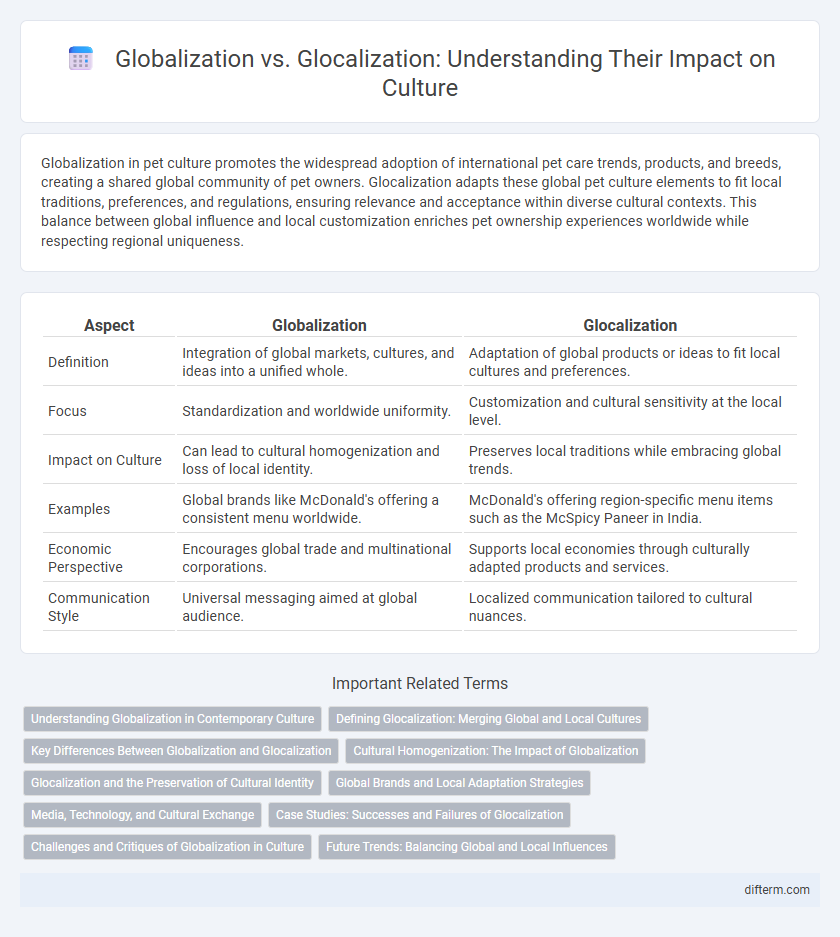Globalization in pet culture promotes the widespread adoption of international pet care trends, products, and breeds, creating a shared global community of pet owners. Glocalization adapts these global pet culture elements to fit local traditions, preferences, and regulations, ensuring relevance and acceptance within diverse cultural contexts. This balance between global influence and local customization enriches pet ownership experiences worldwide while respecting regional uniqueness.
Table of Comparison
| Aspect | Globalization | Glocalization |
|---|---|---|
| Definition | Integration of global markets, cultures, and ideas into a unified whole. | Adaptation of global products or ideas to fit local cultures and preferences. |
| Focus | Standardization and worldwide uniformity. | Customization and cultural sensitivity at the local level. |
| Impact on Culture | Can lead to cultural homogenization and loss of local identity. | Preserves local traditions while embracing global trends. |
| Examples | Global brands like McDonald's offering a consistent menu worldwide. | McDonald's offering region-specific menu items such as the McSpicy Paneer in India. |
| Economic Perspective | Encourages global trade and multinational corporations. | Supports local economies through culturally adapted products and services. |
| Communication Style | Universal messaging aimed at global audience. | Localized communication tailored to cultural nuances. |
Understanding Globalization in Contemporary Culture
Globalization in contemporary culture represents the widespread exchange of ideas, values, and traditions driven by technology, media, and economic integration, fostering interconnectedness among diverse societies. The process emphasizes cultural homogenization while simultaneously encouraging the adaptation of global influences to fit local contexts, a phenomenon known as glocalization. Understanding globalization requires analyzing how cultural identity evolves through this dynamic interplay between worldwide cultural flows and localized reinterpretations.
Defining Glocalization: Merging Global and Local Cultures
Glocalization refers to the strategic blend of global ideas and local cultural elements, allowing multinational companies and communities to adapt products, services, and practices to fit specific regional customs and preferences. This process preserves local identity while embracing global interconnectedness, fostering cultural diversity within a unified global framework. The practice of glocalization enhances cultural relevance and economic success by tailoring global innovations to meet local needs and values.
Key Differences Between Globalization and Glocalization
Globalization refers to the process of increasing interconnectedness and integration of economies, cultures, and populations worldwide, emphasizing standardized practices and global unity. Glocalization adapts global products and ideas to fit local cultures and preferences, blending global influences with local traditions to maintain cultural uniqueness. Key differences include globalization's focus on homogenization versus glocalization's emphasis on cultural adaptation and localization strategies.
Cultural Homogenization: The Impact of Globalization
Globalization drives cultural homogenization by spreading dominant cultural norms, languages, and consumer habits across diverse regions, leading to the erosion of local traditions. Media conglomerates and multinational corporations play pivotal roles in promoting uniform cultural products, reducing cultural diversity worldwide. This process often marginalizes indigenous cultures, threatening unique identities and heritage in favor of a more standardized global culture.
Glocalization and the Preservation of Cultural Identity
Glocalization empowers communities to adapt global influences while preserving their unique cultural identities, fostering cultural diversity amid global integration. This process supports local traditions by blending international trends with indigenous customs, thereby strengthening cultural resilience. Emphasizing glocalization promotes sustainable cultural heritage, ensuring distinct identities thrive despite globalization's homogenizing pressures.
Global Brands and Local Adaptation Strategies
Global brands leverage glocalization by adapting marketing strategies and product offerings to resonate with local cultures while maintaining a consistent global identity. Effective local adaptation involves tailoring language, cultural symbols, and consumer preferences, which enhances brand acceptance and customer loyalty in diverse markets. This balance between global standardization and local customization drives competitive advantage and sustainable growth for multinational corporations.
Media, Technology, and Cultural Exchange
Globalization accelerates cultural exchange through widespread media platforms and advanced technology, enabling instant access to diverse content worldwide. Glocalization adapts global media to local cultures, blending international formats with indigenous values to preserve cultural uniqueness. Technological innovations facilitate this dual process by supporting both universal connectivity and localized cultural expression.
Case Studies: Successes and Failures of Glocalization
The success of McDonald's adaptation of its menu to local tastes in India, such as offering McAloo Tikki burgers, exemplifies effective glocalization by respecting cultural dietary preferences while maintaining global brand identity. Conversely, Walmart's failure to adapt to South Korea's retail culture led to its market exit, highlighting that lack of local customization can result in business failure. These case studies demonstrate that glocalization requires deep cultural insights to balance global consistency with local relevance for sustainable success.
Challenges and Critiques of Globalization in Culture
Globalization often leads to cultural homogenization, threatening the preservation of indigenous traditions and languages by promoting dominant global cultures, especially Western norms. Critics argue it exacerbates cultural imperialism, where local identities are overshadowed by multinational corporations and global media, resulting in the loss of cultural diversity. Challenges include resistance to uniform global values and the difficulty in balancing cultural exchange with the protection of unique local heritage.
Future Trends: Balancing Global and Local Influences
Future trends in culture emphasize the balance between globalization and glocalization, where global connectivity expands access to diverse ideas while local communities preserve unique traditions. Advanced technologies and digital platforms enable localized expressions within global networks, fostering cultural hybridity that respects authenticity. Businesses and policymakers focus on adaptive strategies that integrate global standards with local cultural values to enhance sustainable development and social cohesion.
globalization vs glocalization Infographic

 difterm.com
difterm.com